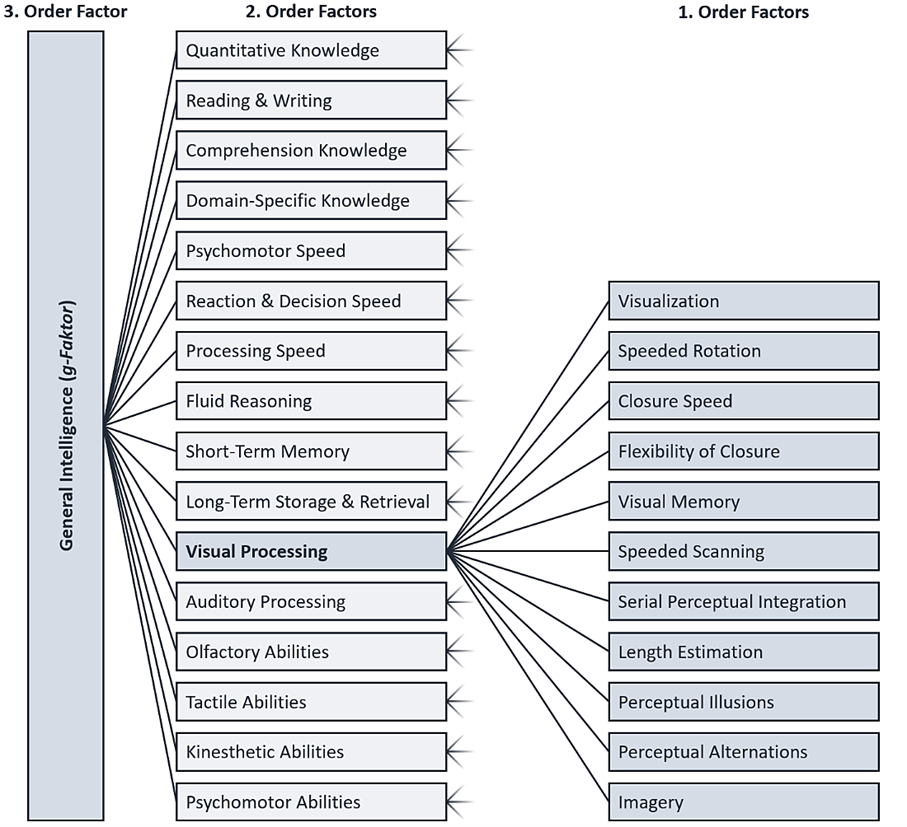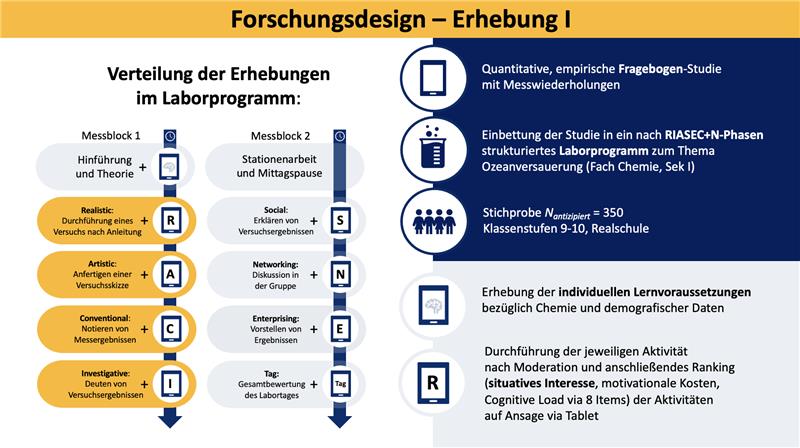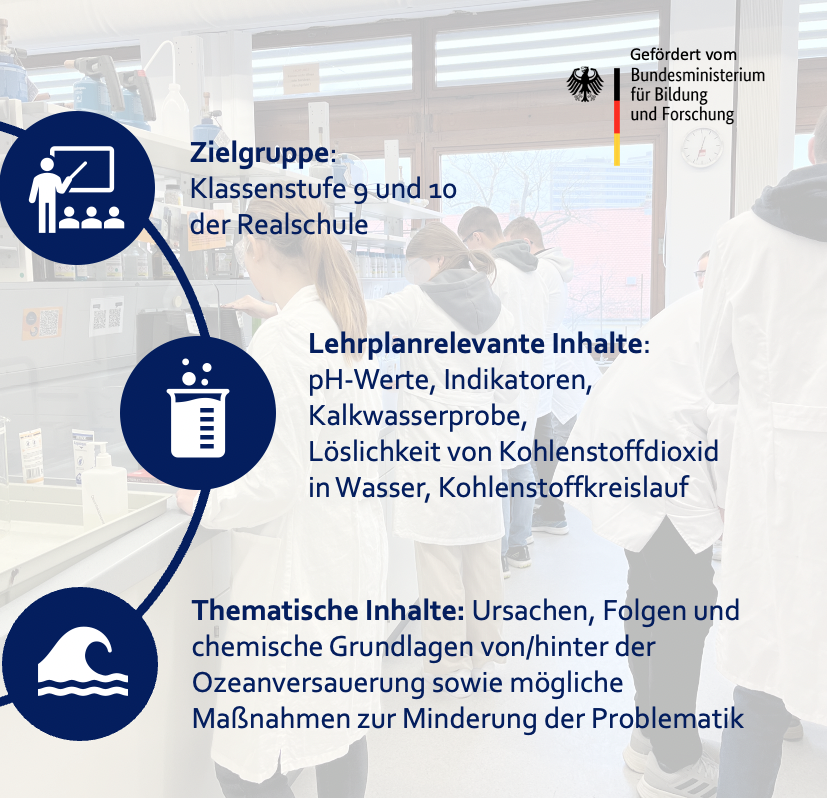Research
The research interests of the chair are associated with empirical, chemistry-related teaching and learning research. We are interested in how chemistry-related learning opportunities can be designed to facilitate successful learning processes for students and what role individual learning prerequisites play in this. For example, we investigate how chemistry-related visualizations can be meaningfully integrated into learning opportunities and which competencies learners should possess to benefit from them.
Current projects
Spatial Skills in Chemistry – More Than Just Mental Rotation?
Initial Situation & Theoretical Background

In chemistry, visual representations play a key role in understanding subject-specific concepts (Kozma & Russell, 2007) and in problem-solving (Rau, Zahn, Misback, Herder, & Burstyn, 2021). The use of diagrams, molecular structures, and reaction mechanisms in 2D and 3D are just some examples of how representations are employed in chemistry (Harle & Towns, 2011). This requires specific competencies, such as the ability to translate between representations and recognize connections between them (Kozma & Russell, 2007).
In this context, spatial skills also play an important role: they positively influence the handling and learning with representations (Carter, LaRussa, & Bodner, 1987; Buckley, Seery, & Canty, 2018). Spatial skills are one of 16 facets of general intelligence according to the Cattell-Horn-Carroll model (Carroll, 1993; Schneider & McGrew, 2012). They can be understood as the ability to create, mentally store, and manipulate abstract visual images (Lohman, 1979). Spatial skills can be differentiated into 11 factors (Fig. 1), for example, mental rotation, spatial visualization, and spatial orientation (Buckley, Seery, & Canty, 2018).
In most STEM studies that consider spatial skills, usually only one factor of spatial abilities is used, e.g., mental rotation. However, how different factors of spatial skills affect the performance on representation-based chemistry tasks is still little researched and requires further investigation.
Research Questions & Methodology
- Which factors of spatial abilities play a role in solving representation-based chemistry tasks?
A test to assess spatial abilities is being compiled, consisting of self-developed and adapted test items (Averbeck, 2021; Taskin, Bernholt, & Parchmann, 2015) that cover various subfields of chemistry. Construct validity will be determined through interrater reliability (assignment of test items by subject matter experts). The factors of spatial abilities will be measured using validated test instruments according to Ekstrom, French, Harman, and Derman (1976), such as the Hidden Figure Test and the Paper Folding Test. After validating the developed test, the data will be collected using a multi-matrix sampling approach (Childs & Jaciw, 2002). Data will be gathered in a quasi-longitudinal design with Bachelor of Science students in chemistry or related fields at the beginning and end of their undergraduate studies. The relationship between spatial ability factors and specific representations and representation competencies will be analyzed through correlation and regression analyses.
- To what extent does the development of specific spatial ability factors influence the learning success of chemistry students?
Based on the results of the first research question, an intervention study will be designed to specifically promote the spatial ability factors identified as relevant. A pre-post design with intervention group(s) and a control group is planned to examine whether this targeted training can improve learning outcomes in representation-based chemistry tasks.
Project outcome
The results of the project contribute to the investigation of the mechanisms by which factors of spatial abilities affect learning success with external representations in chemistry. This can reveal opportunities to improve students’ learning outcomes through targeted development of specific spatial ability factors.
Sebastian Nickel
Wissenschaftlicher Mitarbeiter
Literature
- Averbeck, D. (2021). Zum Studienerfolg in der Studieneingangsphase des Chemiestudiums – Der Einfluss kognitiver und affektiv-motivationaler Variablen. Berlin: Logos.
- Buckley, J., Seery, N., & Canty, D. (2018). A Heuristic Framework of Spatial Ability: a Review and Synthesis of Spatial Factor Literature to Support its Translation into STEM Education. Educational Psychology Review, 30(3), S. 947–972.
- Carroll, J. B. (1993). Human cognitive abilities – A survey of factor-analytic studies. Cambridge: Cambridge University Press.
- Carter, C. S., LaRussa, M. A., & Bodner, G. M. (1987). A study of two measures of spatial ability as predictors of success in different levels of general chemistry. Journal of Research in Science Teaching, 24(7), S. 645-657.
- Childs, R. A., & Jaciw, A. P. (2002). Matrix Sampling of Items in Large-Scale Assessments. Practical Assessment, Research, and Evaluation, 8(Artikel 16).
- Ekstrom, R. B., French, J. W., Harman, H. H., & Derman, D. (1976). Coverbild für Manual for kit of factor-referenced cognitive tests. Princeton, New Jersey: Education Testing Service.
- Harle, M., & Towns, M. (2011). A Review of Spatial Ability Literature, Its Connection to Chemistry, and Implications for Instruction. Journal of Chemical Education, 88(3), S. 351-360.
- Kozma, R., & Russell, J. (2007). Students Becoming Chemists: Developing Representational Competence. In J. K. Gilbdert (Hrsg.), Visualization in Science Education (S. 121-146). Dordrecht: Springer.
- Lohman, D. F. (1979). Spatial ability: A review and reanalysis of the correlational literature . Stanford (CA): Aptitudes Research Project, School of Education und Stanford University.
- Rau, M. A., Zahn, M., Misback, E., Herder, T., & Burstyn, J. (2021). Adaptive support for representational competencies during technology-based problem solving in chemistry. Journal of the Learning Sciences, 30(2), S. 163-203.
- Schneider, J., & McGrew, K. (2012). The Cattell-Horn-Carroll (CHC) Model of Intelligence. In D. P. Flanagan, & E. M. McDonough, Contemporary Intellectual Assessment – Theories, Tests, and Issues (3. Ausg., S. 99-144). New York: Guilford Publications.
- Taskin, V., Bernholt, S., & Parchmann, I. (2015). An inventory for measuring student teachers’ knowledge of chemical representations: design, validation, and psychometric analysis. Chemistry Education Research and Practice, 16(3), S. 460-477.
Activity-Linked Assessment of Motivational Factors in the Student Laboratory
Student laboratories have long been an established part of the German education landscape and are considered a promising approach to increasing interest in STEM subjects, which tend to be less popular, due to their positive influence on affective and motivational characteristics of participating students (Tillmann & Wegner, 2021; Eilks & Hofstein, 2015).
Interest, according to Krapp’s person-object theory (1992; 1998), is defined as the relationship between a person and an object of interest (e.g., an object, idea, or activity). From the interaction between the person and the object of interest, situational interest can arise, which is described as a temporally unstable and context-dependent psychological state (state) (Kelava et al., 2020). Through internalization, this state can be transformed into individual interest, which is considered a relatively stable personality trait over time (trait) (Krapp, 1992; Kelava et al., 2020).
Student laboratories often aim to foster the emergence of situational interest, as it can be triggered by activities or the environment (Su et al., 2019). At this point, a crucial question arises: Is the prevailing interest of students in a student laboratory truly situational, or does individual interest dominate? Depending on the outcome, comprehensive restructuring measures for such laboratory offerings might be necessary.
To break down the components of interest measurement attributable to the person (individual interest) versus the situation/interaction between situation and person (situational interest), latent-state-trait analyses are suitable (Kelava et al., 2020). This is to be repeated in relation to the little-researched motivational costs (Rosenzweig et al., 2019).
These considerations lead to the following research questions:
FF1: To what extent do … change
- situational interest
- motivational costs
depending on the activity phase at the extracurricular learning site (student laboratory)?
FF2: To what extent
- is the interest
- are the motivational costs
in the respective activity phase, dispositionally (trait) or situationally (state) determined?
For the study, a student laboratory program on the topic of ocean acidification (target group: lower secondary level of Realschule) was developed, which includes seven ranking situations derived from the RIASEC+N model of interest dimensions during scientific activities (Dierks et al., 2016).
The ranking of the respective activities takes place after each activity phase via a questionnaire on a tablet, in the form of a quantitative survey study with repeated measurements. The constructs of “situational interest,” “motivational costs,” and “cognitive load” are assessed using a total of 8 items on a Likert scale. Additionally, individual interest related to the subject of chemistry, other individual learning prerequisites (e.g., chemistry self-concept), and demographic data are collected before the laboratory program and after the theoretical introduction.
Following a pilot phase, Study Phase I is currently in the final stages of data collection, aiming for a sample size of approximately 350 participants.
The activity-based rankings are analyzed not only descriptively but also through extreme group analyses, correlation and regression analyses, a repeated measures ANOVA, and a latent-state-trait analysis (including confirmatory analysis as well as variance decomposition and the resulting determination of consistency and specificity coefficients). This is done to answer the research questions, draw implications for student laboratory operations, and identify further research needs, among others for Study Phase II (e.g., an intervention study for differentiated interest enhancement).

Literature:
- Dierks, P., Höffler, T.; Blankenburg, J., Peters, H. & Parchmann, I. (2016) Interest in science: a RIASEC-based analysis of students’ interests, International Journal of Science Education, 38:2, 238-258
- Eilks, I., & Hofstein, A. (2015). Relevant Chemistry Education – From Theory to Practice (1-10). Rotterdam: Sense Publishers.
- Kelava, A., Schermelleh-Engel, K. & Mayer, A. (2020). Latent-State-Trait-Theorie (LST-Theorie). In H. Moosbrugger & A. Kelava (Hrsg.), Testtheorie und Fragebogenkonstruktion (3., vollständig überarbeitete und ergänzte Auflage). Heidelberg: Springer
- Krapp, A. (1992). Das Interessenskonstrukt. Bestimmungsmerkmale der Interessenshandlung und des individuellen Interesses aus der Sicht einer Person-Gegenstands-Konzeption. In A. Krapp & M. Prenzel (ed.), Interesse, Lernen, Leistung. Neuere Ansätze einer pädagogisch-psychologischen Interessensforschung, (26, 297-330). Münster: Aschendorff.
- Krapp, A. (1998). Entwicklung und Förderung von Interessen im Unterricht. Psychologie in Erziehung und Unterricht, 44(3), 185-201.
- Rosenzweig, E. Q., Wigfield, A., & Eccles, J. S. (2019). Expectancy-value theory and its relevance for student motivation and learning.
In Renninger, K. A., & Hidi, S. E. (Eds.), The Cambridge handbook of motivation and learning. 617–644. Cambridge University Press. - Su R., Stoll G., Rounds J. (2019). The nature of interests: Toward a unifying theory of trait–state interest dynamics. In Nye C. D., Rounds J. (Eds.), Vocational interests: Rethinking their role in understanding workplace behavior and practice. SIOP organizational Frontiers series. New York, NY: Routledge.
- Tillmann, J., & Wegner, C. (2021). Weiterentwicklung eines klassischen Schülerlabors – Darstellung des aktuellen Forschungsstandes. Progress in Science Education (PriSE), 4(2)
Completed Projects
What is the project about?
The project investigates the potential of augmented reality (AR)-supported external representations in learning organic chemistry content. Within the framework of two experimental studies, the hypothesis is tested that students are relieved during the learning process by embedding interactive, three-dimensional visualizations into traditional text-image-based instructional materials, as the digital medium alleviates the translation of implicit spatial information. Individual learning prerequisites of the participating students are also considered, as a moderating role of general spatial abilities is assumed. For conducting the studies, the learning application ARC (Augmented Reality Chemistry) was developed, which is intended to be made available to both university students and school pupils in the future.
Project Participants:
Sebastian Keller (Uni Duisburg-Essen)
Prof. Dr. Stefan Rumann (Uni Duisburg-Essen)
Project-Related Publications:
- Keller, S., Rumann, S., & Habig, S. (2021). Cognitive Load Implications for Augmented Reality Supported Chemistry Learning. Information, 12(3), 96.
- Habig, S. (2020). Who can benefit from augmented reality in chemistry? Sex differences in solving stereochemistry problems using augmented reality. British Journal of Educational Technology, 51(3), 629-644.

Projektnummer 415026237
Information about the SiL:360 project will be available shortly.
The Ocean in a Test Tube:
The acronym KOALa stands for “Investigating the Effects of Climate Change on the Ocean and Atmosphere in the Laboratory” and focuses on the issue of ocean acidification as its central theme. In addition, students gain insights into typical activities associated with laboratory-related professions as part of the program.

Because green turns to yellow, there’s not much left of the coral reef: The lab day begins by exploring the mystery behind this riddle. Inspired by the game concept of Black Stories, students work in small groups to investigate various lab stations, preceded by a crash course on acids and bases. Through experimentation, they gather the relevant information needed to solve the riddle.
The station work addresses the causes, consequences, and basic chemical principles related to the main theme of ocean acidification. Students are supported by experienced lab staff as well as a digital lab journal on a tablet, which provides not only experimental instructions but also interactive H5P-based learning elements and short videos.
Problem identified – so how can it be solved?
In the second part of the lab day, students take on the role of Ocean Designers and model the “ideal” conditions for an ocean in which as little carbon dioxide as possible dissolves, in order to reduce the resulting acidification problem. The necessary background knowledge (e.g., the chemical and physical effects of pressure or temperature on the solubility of carbon dioxide in water) is also explored through hands-on experiments at various stations.
The developed ocean designs are then discussed in a plenary session and critically evaluated, particularly regarding their feasibility and the underlying scientific and environmental issues. Finally, the crucial question arises: What options does an individual have to help counteract ocean acidification? A concluding brainstorming session is intended to provide food for thought for the way home and raise awareness for the responsible use of resources in everyday life.

The project was funded as part of the action program “Catching Up After COVID-19 for Children and Adolescents” by the German Federal Ministry of Education and Research (BMBF) during the period from January 1, 2022, to December 31, 2022.


